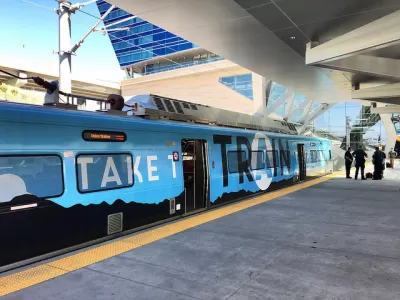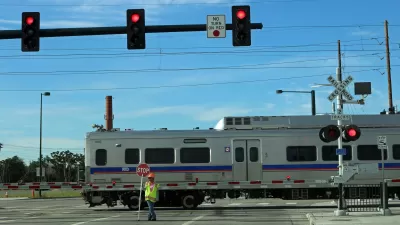Ridership on the electrified A Line, which opened to great fanfare on Earth Day, reached a weekday average of 16,910 as of June 5. The 23-mile line operates from Union Station to Denver International Airport. Not all is perfect though.

The University of Colorado A Line "enjoys an on-time performance average of 89 percent, said Dave Genova, Regional Transportation District’s general manager," writes Monte Whaley, Denver Post reporter covering transportation. "And overall ridership during its sixth week of operation — from May 30 to June 5 — hit a new weekday average of 16,910."
Genova admitted there were “things we did not see in testing. And I’m not satisfied with our performance as it is,” he said.
The record ridership makes the 23-mile line the 11th busiest commuter rail line in the U.S., just after the 83-mile UTA Frontrunner commuter line that opened in 2008, according to March 2016 data from the American Public Transportation Association via Wikipedia.
Ridership would appear to be influenced by passenger traffic at DIA, which surged in April.
However, some Regional Transportation District (RTD) board members are nonetheless concerned about operation problems which have surfaced, writes Whaley. For the second time since service began on April 22, lightning strikes halted service for about two hours on June 13.
Grade Crossings
While the A Line has some of the operating features of heavy rail, such as operating frequency, hours of operation, and level boarding, not all grade crossings are separated, and that can create problems when power is lost, such as during lightning strikes.
"RTD workers are still at 10 train crossings along the A-Line route to make sure gates are working properly, said RTD spokesman Nate Currey [on June 13].
More extensive problems at the crossings, which are also used by Union Pacific Railroad, particularly with the crossing gates, were detailed by Whaley and Denver Post staff writer John Aguilar last month.
Positive Train Control
"RTD board chair Tom Tobiassen said the new technology being used on the A-Line — including Positive Train Control (PTC) to prevent derailments or collisions — is a challenge to implement," wrote Whaley and Aguilar.
“We are the only transit agency that has Positive Train Control built into its system, everybody is watching what we do,” Tobiassen said [May 10]. “Everybody is going to learn a lot from this.”
Extra costs incurred at the grade crossings appear to be borne by Denver Transit Partners, the private partner in RTD's successful Eagle P3 Project, the nation's first full public-private partnership for transit.
Look for RTD's second commuter line, the 6-mile, Northwest B Line from Union Station to Westminster Station, to begin service on July 25, 2016.
Hat tip to Annie Dawid.
FULL STORY: Union Station-DIA train criticized by RTD board

Alabama: Trump Terminates Settlements for Black Communities Harmed By Raw Sewage
Trump deemed the landmark civil rights agreement “illegal DEI and environmental justice policy.”

Planetizen Federal Action Tracker
A weekly monitor of how Trump’s orders and actions are impacting planners and planning in America.

How Atlanta Built 7,000 Housing Units in 3 Years
The city’s comprehensive, neighborhood-focused housing strategy focuses on identifying properties and land that can be repurposed for housing and encouraging development in underserved neighborhoods.

In Both Crashes and Crime, Public Transportation is Far Safer than Driving
Contrary to popular assumptions, public transportation has far lower crash and crime rates than automobile travel. For safer communities, improve and encourage transit travel.

Report: Zoning Reforms Should Complement Nashville’s Ambitious Transit Plan
Without reform, restrictive zoning codes will limit the impact of the city’s planned transit expansion and could exclude some of the residents who depend on transit the most.

Judge Orders Release of Frozen IRA, IIJA Funding
The decision is a victory for environmental groups who charged that freezing funds for critical infrastructure and disaster response programs caused “real and irreparable harm” to communities.
Urban Design for Planners 1: Software Tools
This six-course series explores essential urban design concepts using open source software and equips planners with the tools they need to participate fully in the urban design process.
Planning for Universal Design
Learn the tools for implementing Universal Design in planning regulations.
Jessamine County Fiscal Court
Caltrans
Institute for Housing and Urban Development Studies (IHS)
City of Grandview
Harvard GSD Executive Education
Toledo-Lucas County Plan Commissions
Salt Lake City
NYU Wagner Graduate School of Public Service




























